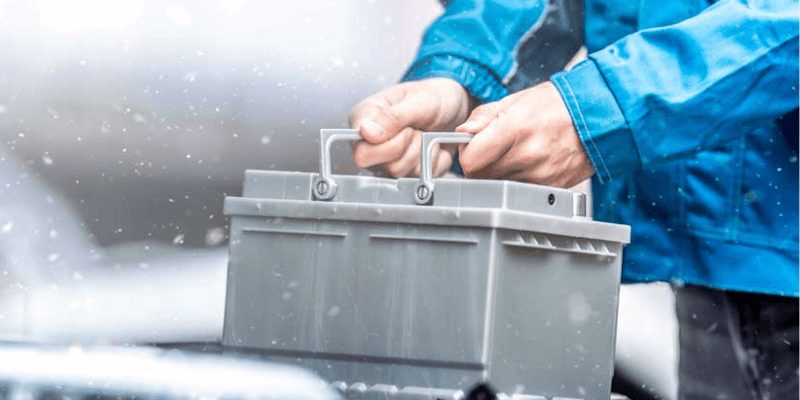Poin Penting:
- Baterai lebih menyukai suhu sedang untuk kinerja optimal.
- Suhu dingin dapat menyebabkan pelapisan litium, peningkatan tekanan, dan pembekuan elektrolit.
- Panas dapat menyebabkan pengisian daya yang berlebihan, ventilasi, dan berkurangnya kapasitas.
Pernah bertanya-tanya bagaimana kinerja baterai Anda dalam suhu ekstrem? Mari kita jelajahi bagaimana baterai berperilaku pada suhu ekstrem saat ini. Anda mungkin terkejut!
Masalah Pengisian Daya pada Suhu Ekstrim
Suhu Dingin
Kita semua pernah mendengar bahwa baterai menyukai suhu ruangan, bukan? Tapi tahukah Anda apa yang terjadi jika Anda mengisi baterai dalam keadaan dingin?
- Baterai Litium-Ion: Pernah mendengar tentang pelapisan litium sebelumnya? Ini seperti jika baterai litium-ion menjadi terlalu dingin, ion litium akan menempel di anoda. Siapa tahu, malah bisa menyebabkan pesta arus pendek. Dan jika elektrolitnya terlalu dingin, ia dapat membeku dan memecahkan casingnya. Aduh!
- Baterai Asam Timbal yang Kebanjiran: Orang-orang ini seperti kerucut salju di musim dingin. Elektrolitnya bisa membeku dan mengembang, dan meledak! Kasusnya mungkin rusak.
- Baterai Berbasis Nikel: Cuaca dingin dapat memperlambat reaksi kimianya, sehingga menyebabkan peningkatan tekanan. Ini seperti ketika Anda mencoba meledakkan balon terlalu cepat!
Suhu Panas
Mengisi daya dalam cuaca panas? Bukan ide yang bagus juga.
- Baterai Litium-Ion: Mereka dapat menerima panas, tetapi jika terlalu banyak, mereka mungkin akan terengah-engah mencari udara dan mengeluarkan udara. Hal ini dapat memperpendek umur mereka. Sama seperti saat Anda berlari terlalu cepat dan perlu mengatur napas.
- Baterai Berbasis Nikel: Panas dapat membuat baterai bingung mengenai seberapa terisi dayanya, sehingga menyebabkan pengisian daya yang berlebihan. Ini mirip dengan ketika Anda terlalu banyak mengonsumsi permen dan akhirnya merasa tidak enak.
- Baterai Asam Timbal yang Kebanjiran: Temperatur yang tinggi dapat menyebabkan baterai terisi daya secara berlebihan, sehingga mempercepat penuaannya.
Masalah Pengosongan pada Suhu Ekstrim
Suhu Dingin
Mengosongkan air dalam cuaca dingin bisa sangat merugikan. Inilah alasannya:
- Kinerja Umum: Baterai mengalami kesulitan dalam cuaca dingin, dengan resistansi yang lebih tinggi menyebabkan penurunan kapasitas. Bayangkan baterai Anda seperti pahlawan super yang separuh kekuatannya berada pada suhu 0°F.
- Pemulihan: Panas dapat mengurangi separuh masa pakai baterai, seperti saat Anda hanya mendapatkan setengah sendok es krim yang Anda inginkan. Tidak keren!
Suhu Panas
Menurutmu cuaca panas lebih mudah? Tidak secepat itu.
- Kapasitas Berkurang: Panas bisa mempersingkat waktu siklus hidup baterai. Beberapa baterai hanya dapat menyediakan 50% kapasitasnya pada suhu 113°F.
Kisaran Suhu Pengisian dan Pengosongan
Baterai memiliki zona nyamannya masing-masing. Pertahankan rentang berikut agar baterai Anda tetap nyaman:
- Baterai Litium-Ion: Isi daya dari 32°F hingga 113°F, Debit dari -4°F hingga 140°F
- Baterai Asam Timbal: Isi daya dari -4°F hingga 122°F, Debit dari -4°F hingga 122°F
- Baterai Berbasis Nikel: Isi daya dari 32°F hingga 113°F, Debit dari -4°F hingga 149°F
Produsen baterai mungkin punya solusi khusus, namun dengan mematuhi pedoman ini dapat menjaga baterai Anda tetap dalam kondisi prima.
Kesimpulan
Mengelola baterai dalam suhu ekstrem bukanlah hal yang mudah. Dengan mengetahui batasan baterai pada suhu ekstrem agar baterai tetap kuat. Sedikit perhatian yang cerdas akan sangat bermanfaat!
Artikel Terkait:

